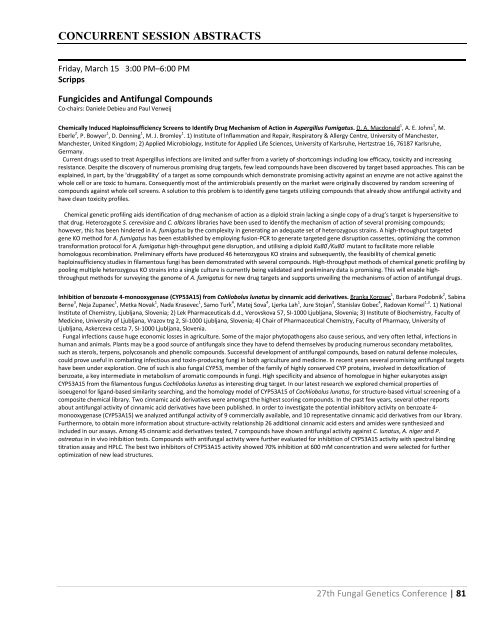Program Book - 27th Fungal Genetics Conference
Program Book - 27th Fungal Genetics Conference
Program Book - 27th Fungal Genetics Conference
Create successful ePaper yourself
Turn your PDF publications into a flip-book with our unique Google optimized e-Paper software.
CONCURRENT SESSION ABSTRACTSFriday, March 15 3:00 PM–6:00 PMScrippsFungicides and Antifungal CompoundsCo-chairs: Daniele Debieu and Paul VerweijChemically Induced Haploinsufficiency Screens to Identify Drug Mechanism of Action in Aspergillus Fumigatus. D. A. Macdonald 1 , A. E. Johns 1 , M.Eberle 2 , P. Bowyer 1 , D. Denning 1 , M. J. Bromley 1 . 1) Institute of Inflammation and Repair, Respiratory & Allergy Centre, University of Manchester,Manchester, United Kingdom; 2) Applied Microbiology, Institute for Applied Life Sciences, University of Karlsruhe, Hertzstrae 16, 76187 Karlsruhe,Germany.Current drugs used to treat Aspergillus infections are limited and suffer from a variety of shortcomings including low efficacy, toxicity and increasingresistance. Despite the discovery of numerous promising drug targets, few lead compounds have been discovered by target based approaches. This can beexplained, in part, by the ‘druggability’ of a target as some compounds which demonstrate promising activity against an enzyme are not active against thewhole cell or are toxic to humans. Consequently most of the antimicrobials presently on the market were originally discovered by random screening ofcompounds against whole cell screens. A solution to this problem is to identify gene targets utilizing compounds that already show antifungal activity andhave clean toxicity profiles.Chemical genetic profiling aids identification of drug mechanism of action as a diploid strain lacking a single copy of a drug’s target is hypersensitive tothat drug. Heterozygote S. cerevisiae and C. albicans libraries have been used to identify the mechanism of action of several promising compounds;however, this has been hindered in A. fumigatus by the complexity in generating an adequate set of heterozygous strains. A high-throughput targetedgene KO method for A. fumigatus has been established by employing fusion-PCR to generate targeted gene disruption cassettes, optimizing the commontransformation protocol for A. fumigatus high-throughput gene disruption, and utilising a diploid Ku80 - /Ku80 - mutant to facilitate more reliablehomologous recombination. Preliminary efforts have produced 46 heterozygous KO strains and subsequently, the feasibility of chemical genetichaploinsufficiency studies in filamentous fungi has been demonstrated with several compounds. High-throughput methods of chemical genetic profiling bypooling multiple heterozygous KO strains into a single culture is currently being validated and preliminary data is promising. This will enable highthroughputmethods for surveying the genome of A. fumigatus for new drug targets and supports unveiling the mechanisms of action of antifungal drugs.Inhibition of benzoate 4-monooxygenase (CYP53A15) from Cohliobolus lunatus by cinnamic acid derivatives. Branka Korosec 1 , Barbara Podobnik 2 , SabinaBerne 3 , Neja Zupanec 1 , Metka Novak 1 , Nada Krasevec 1 , Samo Turk 4 , Matej Sova 4 , Ljerka Lah 1 , Jure Stojan 3 , Stanislav Gobec 4 , Radovan Komel 1,3 . 1) NationalInstitute of Chemistry, Ljubljana, Slovenia; 2) Lek Pharmaceuticals d.d., Verovskova 57, SI-1000 Ljubljana, Slovenia; 3) Institute of Biochemistry, Faculty ofMedicine, University of Ljubljana, Vrazov trg 2, SI-1000 Ljubljana, Slovenia; 4) Chair of Pharmaceutical Chemistry, Faculty of Pharmacy, University ofLjubljana, Askerceva cesta 7, SI-1000 Ljubljana, Slovenia.<strong>Fungal</strong> infections cause huge economic losses in agriculture. Some of the major phytopathogens also cause serious, and very often lethal, infections inhuman and animals. Plants may be a good source of antifungals since they have to defend themselves by producing numerous secondary metabolites,such as sterols, terpens, polycosanols and phenolic compounds. Successful development of antifungal compounds, based on natural defense molecules,could prove useful in combating infectious and toxin-producing fungi in both agriculture and medicine. In recent years several promising antifungal targetshave been under exploration. One of such is also fungal CYP53, member of the family of highly conserved CYP proteins, involved in detoxification ofbenzoate, a key intermediate in metabolism of aromatic compounds in fungi. High specificity and absence of homologue in higher eukaryotes assignCYP53A15 from the filamentous fungus Cochliobolus lunatus as interesting drug target. In our latest research we explored chemical properties ofisoeugenol for ligand-based similarity searching, and the homology model of CYP53A15 of Cochliobolus lunatus, for structure-based virtual screening of acomposite chemical library. Two cinnamic acid derivatives were amongst the highest scoring compounds. In the past few years, several other reportsabout antifungal activity of cinnamic acid derivatives have been published. In order to investigate the potential inhibitory activity on benzoate 4-monooxygenase (CYP53A15) we analyzed antifungal activity of 9 commercially available, and 10 representative cinnamic acid derivatives from our library.Furthermore, to obtain more information about structure-activity relationship 26 additional cinnamic acid esters and amides were synthesized andincluded in our assays. Among 45 cinnamic acid derivatives tested, 7 compounds have shown antifungal activity against C. lunatus, A. niger and P.ostreatus in in vivo inhibition tests. Compounds with antifungal activity were further evaluated for inhibition of CYP53A15 activity with spectral bindingtitration assay and HPLC. The best two inhibitors of CYP53A15 activity showed 70% inhibition at 600 mM concentration and were selected for furtheroptimization of new lead structures.<strong>27th</strong> <strong>Fungal</strong> <strong>Genetics</strong> <strong>Conference</strong> | 81











